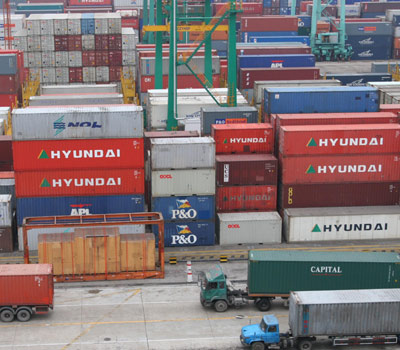|
China remains world's 3rd largest trader
By Jiang Wei (China Daily)
Updated: 2006-01-12 07:04
The Chinese mainland recorded US$1.4 trillion in foreign trade volume last
year, helping China to remain the third largest trader in the world.
Behind the big figures though, a widening trade surplus
is arousing the concerns of trade partners.

A port in Nanjing, East China's Jiangsu
Province is seen in this file photo.
[newsphoto] |
Senator Max Baucus, a member of the US Senate Finance Committee, warned that
Washington was likely to take measures to reduce imports from China to narrow
the gap in bilateral trade.
China's General Administration of Customs yesterday said its statistics
showed China's imports and exports grew 23.2 per cent year-on-year to US$1.42
trillion in 2005. The volume nearly tripled that of 2001.
The country's exports stood at US$772 billion in 2005, up 28.4 per cent on
the previous year; imports hit US$660.1 billion, up 17.6 per cent on the year
before.
However, the country's trade surplus in 2005 tripled that of the previous
year, reaching a record US$102 billion.
China saw a trade surplus of over US$100 billion with the United States last
year.
But statistics from the US say the figure is around US$200 billion. The
difference is due to different calculating methods.
China's trade surplus with the United States is not expected to massively
decline this year, said Mei Xinyu, a researcher with the China Academy of
International Trade and Economic Co-operation, a think tank of the China
Ministry of Commerce.
"I would like to contribute the imbalance to the fast economic growth of the
United States and the cooling-down of China's economy in the first half of last
year," he said.
He said China understands that there are many problems wrapped up in the
trade imbalance but these, which were not caused by one single side, must be
solved through mutual efforts.
On one hand, the expert said, growth in China's consumption will help to
solve the problem but "it is difficult to speed up consumption in China in a
short period of time."
On the other hand, the US Government should lift its restrictions on exports
to China so as to narrow the gap.
The United States imposes restrictions on exports of certain products
involving high-technology. The growing trade surpluses have brought about
various trade conflicts, such as textile disputes with the US and the EU and the
EU's claim of the dumping of Chinese shoes.
Although the textile disputes have been settled through negotiations, quotas
that should have been removed were re-introduced into China's textile exports.
Thousands of Chinese footwear producers are waiting to see what will happen
in regards to the EU's investigation into shoe dumping.
Lu Jianhua, director of the Foreign Trade Department of the Ministry of
Commerce, said that this year China is likely to encounter more trade friction,
concerning its exchange rate and trade systems.
"New problems are expected to come to a number of sectors, such as textiles,
household electrical appliances, and the chemical industrial and steel
industries," he said.
Customs statistics said general trade grew 21 per cent to US$594.8 billion in
2005 year-on-year.
The European Union continued to be China's largest trade partner in 2005,
with bilateral trade of US$217.3 billion, up 22.6 per cent year-on-year.
The United States was China's second largest trading partner with US$211.6
billion in bilateral trade, followed by Japan with US$184.4 billion.
China's trade volume with its top six trade partners exceeded US$100 billion
last year for each of them.
Monthly foreign trade in December stood at US$139.8 billion, a new record,
reflecting a yearly increase of 20 per cent.
Exports stood at US$75.4 billion in December, up 18.2 per cent year-on-year,
while imports reached US$ 64.4 billion, up 22.2 per cent over the previous year.
(China Daily 01/12/2006 page9)
|